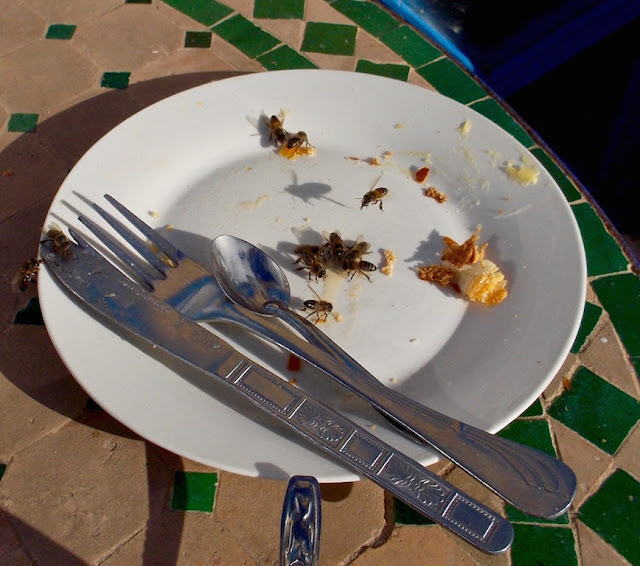The overnight train from Marrakesh to Tangier was not a great experience. We thought we'd booked a 2-bunk cabin but, somewhat to our dismay, it turned out that all the cabins had four bunks and we had to share with a young Japanese guy. He was, however, polite, quiet and self-contained, climbing into the top bunk and making himself about as invisible as he could under the circumstances. The only downside was that he found it cold with the window open, so we sweltered all night in the small, overheated space. In spite of this, I slept reasonably well, though Michael wasn't so lucky.
Unlike trains we've taken in other countries, there were no facilities attached to each cabin or even shared between two, just a single toilet and washbasin at the end of the carriage. Consequently, we arrived in the early morning in Tangier somewhat dishevelled and eager to find our accommodation.
Fortunately, Sophie, our hostess, was amenable to our checking in quite promptly and suggested we make our way to the Hotel Continental overlooking the harbour, where she would meet us. We took a cab there and had breakfast on their terrace while we waited for her to arrive. The hotel, a large building of faded glory perched above the waterfront, is a landmark in Tangier
Tangier is built on a steep hillside, so we climbed up various steps and alleys to Sophie's tall, narrow, white house, tucked onto one corner of a minuscule square.
Our room on the second floor faced onto the internal courtyard. It was attractively furnished, comfortable and very quiet, but without a view. However, a lovely roof deck above, reached by narrow mosaic-inlaid stairs, more than compensated.
This is where we were served breakfast every morning.
The deck commanded sweeping views of the colourful medley of buildings that tumbled down the hillside. We spent quite a lot of time there, enjoying the scenery and the sunshine.
The smoking chimney in the foreground of the photo above serves a wood-fired oven. A common sight in the surrounding streets was Tangier housewives carrying trays of round flat loaves to be baked in these small shops. You knew when they were on their way home at the end of the process by the delicious aroma wafting from under the tray cloth.
Being less of a tourist destination than elsewhere we'd been, Tangier revealed more of the poverty of Morocco. Many of the residents, we were told, did not have running water in their houses. Almost every street had a hammam (public bath) with separate times of day for men and women. Around the corner from our place was a well, visited by a constant stream of men, women and children filling plastic buckets and bottles.
Tourists often see a visit to a hammam as part of their holiday experience. Moroccans are infallibly polite, even when we foreigners trample on their customs. I wonder how they really feel when what is a necessity for them is invaded by rich foreigners for a bit of holiday "fun".
We spent our two days in Tangier wandering the narrow streets and enjoying the ambience of this bustling port at the gateway to the Mediterranean.

Although the impression from above was of a red, white and ochre city, from within the alleys it was almost all blue and white.
One of the advantages of the number of steps linking these small alleys was the absence of the usual crazy young guys on motorbikes. However, they were replaced by boys on bicycles who somehow managed to hurtle down the steps at breakneck speed without killing themselves - or pedestrians, who had to be extremely wary and leap to safety if one of these daredevils came rocketing towards them.
Cars were confined to wider streets at the top of the town. Their progress was slow as they had to negotiate a steady stream of pedestrians. We saw no speed limit signs for the obvious reason that they were unnecessary.

An interesting feature of Tangier was pointed out to us by a self-appointed guide: men and women worship at separate mosques. The men's mosques had the traditional minaret, partially visible in the background of my photo.
The women's mosques had domed roofs.
It was hard to miss the relevance to each of the respective sexes.
Tangier is a compact city. Although we only had two days there, we felt we had had a good look around. As the sun went down on our last evening, we could see through the dusk the ferry we would take the following morning across the Straits of Gibraltar to Tarifa in Spain.




















































